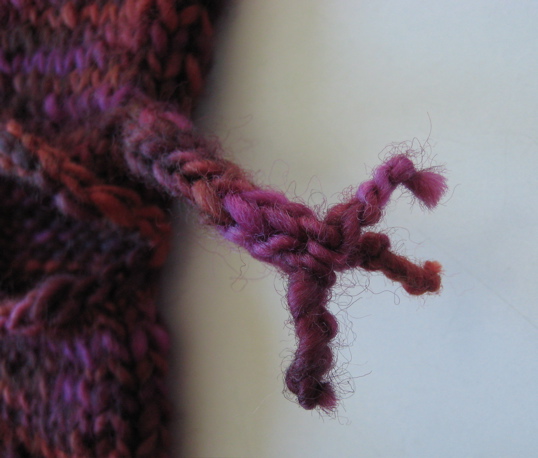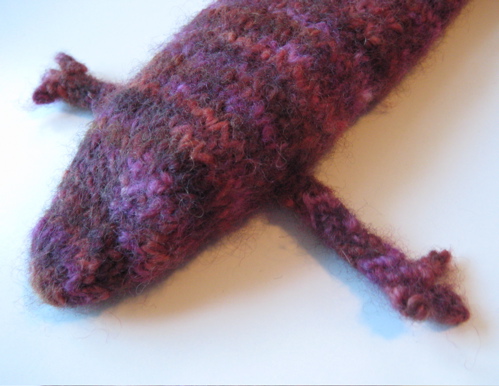[For the non-knitters out there, felting, or fulling, is the process of beating knitted yarn into submission in the washing machine or using another technique to shrink the knitted item and turn it into a dense, durable mat of fiber].
I love felting, particularly for making toys. But one of the things that always bothers me about felting is using the washing machine. I feel so terrible running two whole wash cycles - all that energy and water! - just to turn a non-essential bit of knitting into a non-essential bit of felted knitting.
If you live in the mid-Atlantic or southeastern U.S., you are well aware that we're in a drought. Most of North Carolina (where I live) is now rated as "extreme" drought conditions. We've got mandatory watering restrictions, and I'm relying mainly on the bucket in my shower to get the flowerbeds through from week to week. So running two whole washing machines full of water (at something like 50 gallons per cycle - oh my god!) just to felt a toy salamander seems kind of... well, insane.

here is my knitted salamander's foot, before felting
So I am on the hunt for low-water felting methods. When I mentioned this at my local yarns store, one of the lovely ladies there suggested this method. While the energy input is still quite high, it definitely saved quite a lot of water.
1. Fill a 5-gallon bucket about halfway with very hot water and a tiny bit of mild soap. Submerge your item to be felted, and a towel, in the bucket, and get them both good and wet. Roll the item up in the towel and tie it shut with a piece of string.
2. Toss the roll-up into the dryer with a shoe or something else for agitation. Set your dryer to the lowest heat setting, and run it for about ten minutes.
3. Check your item to see how well it has felted. Repeat step 2 above until it has felted completely.

post-felting. someday he'll even get eyes and external gills.
I'm still looking for ways to cut the electricity, but this method definitely saved plenty of water, which I hope the real salamanders in my neighborhood creek will be happy about.
Some other things I'm thinking of trying, to eliminate the electricity:
- Needle-felting (done with unspun yarn)
- Sticking the item inside a container and dragging it behind my bike on a short ride
- Using one of those ice-cream makers where you stick the ingredients inside a ball and kick it around the yard.
Any other ideas out there?

26 comments:
You know there used to be a way to churn butter. It was a barrel on rockers , like a rocking chair or more like a rocking horse. I dont see why you couldnt use the same concept and build a felting churn.
i've heard of using a plunger in that bucket of water. just like this churning idea.
great post f.pea! and that salamander! cuteness. let us know if/when you try other methods.
There was an article about felting the old fashioned way, using a bucket and a plunger, in the latest issue of Knitty
samoo - i had totally missed the knitty article. a plunger is a great idea!
I've used the plunger and two buckets. One hot and one cold. Shocking the piece from hot to cold helps speed up the felting process.
I've also tossed pieces in (inside a pillowcase) in with regular laundry. Make need a few trips through, but it gets the job done w/out waste.
I usually felt by waiting until I have a few items to felt, and also throwing in other items that won't care if the colors bleed a little and can take the hot water.. old jeans, etc. I use the lowest water setting (depending on other stuff) and put my to-be-felted bits in zipped-up pillow protectors. Then I stop the agitation cycle and reset it every 5-10 minutes until everything is felted (I think you can only do this with a top loading washer). Then I just take out the felted bits and let the rest of the wash go through like normal. Doesn't waste any more water than a normal wash cycle :)
I have heard that pouring boiling water over the item that you wish to felt works quite nicely. You can do this in a small bucket or the sink and then I believe you would need to agitate the fabric a bit... though it is possible that the water works well all by itself. Good luck in your search.... and that is a lovely salamander.
jen
I felt by putting the item in a pillowcase, then add it to my diaper load. That way I'm not using any extra water to finish the project.
I felt in a top-loading washer with some jeans that need a good agitation and the knitted item in a pillow case. I keep the lid up so that I can just reset the agitation part of the cycle if I need to. I wonder if you could just try hot water, a bit of soap and a salad spinner though for a small item (like say, a salamander), might be worth a try.
I've been using a washboard in the sink. It's a workout, but you can really control the felting.
Great ideas! Thanks for sharing about this. And PS: that salamander hand is too cute (never really thought I would say those words...)! ;)
I do a lot of felting. I like the idea of combining with regular loads of laundry.
somebody invented a greenie washer several years ago, in oz I think but I might be wrong. Small weighted cylinder on a frame 9bout the size of a BBQ gas bottle I think) that you filled with your water & items, & when you sealed it up it created a bit of a vacuum. You could then either agitate by turning the handle, or just put it in the back of the car when you drove into town & let the road do the agitating.
Other than that, I suspect you'd find an old fashioned twin-tub washer with the agitator on the bottom would give you the most bang for your electricity buck. We use one to rinse our dyed fabrics - minimal water usage, timing etc very controllable & can be stopped at any point. I imagine it would be dead easy to shock your felting by fishing it out of hot in the washer and dunking into a cold bucket occasionally.
I love the ice cream ball idea! Please let us know if you try it!
I do all of my felting with a regular washload so the water isn't wasted because I get clean clothes too. Some people put their felting item in a pillowcase first but thus far I have not bothered.
You could try a bucket, water, brand new never used toilet plunger, and your feltable. Would be somewhat butter churny in action. Something could be added to aid in agitating the feltable..tennis balls maybe?
Research Wet Felting. It's like needle felting in that it doesn't use yarns, but you can use the techniques on your knit items.
Really all you need to felt most wools should be warm water with some soap added. I like to full on a table with a length of that ribbed plastic mat you buy on a roll from the hardware store (it's like using a washboard, but you have more surface space).
You'll definitely have a lot more control of the felting process, and when it's at the stage you like, just a dunk in cool water & vinegar will finish it off!
Good luck!
Putting the item in a ziploc type bag with hot water and a bit of soap and kneading like bread dough also works for smaller things. Works out the arms too!
I have thought than an old fashioned ice cream churn would work, too. I've been looking for one at thrift stores but havn't found it yet. I remember as a kid spending forever cranking the handle to make ice cream... I think if used for felting, not including the inner container where the ice cream normally goes would be the way to do it.
I also wonder if a larger electric ice cream churn would work?
And, there are butter churns that would work, too. Lehmans.com has them, but they're kinda pricey just for felting. Still, worth a thought.
I use a front loading washer and felt in it quite successfully. I try to save up hot water wash items until I have enough for a couple of loads so i can felt without guilt The only thing I don't do with the items to be felted are towels. Jeans and Keds sneakers always apprciate a hot water wash with lots of agtation!
This may sound weird-but for the heat,how about residual heat after you've used your oven? A just used but turned off oven,wet worked item snuggly wrapped in tinfoil(that you'll reuse later),and let it bask in the leftover heat?I make bread crumbs by laying the ends no one wants,or slightly stale bread,on a cookie sheet,put in a turned off oven,and forget it for a while.Then crush the crispy slices later.No,I haven't tried felting in the oven yet-maybe on a scrap to test it.
On hot days,how about placing it on the sun deck of your car-that's the area below the back windshield.Especially if it's going to be parked in the sun-hey,people dry herbs like that!
My mom felted (fulled) a purse with a washboard. It turned out great and she was really pleased with how she could control the felting process.
Yeah, I used to throw my felting in with Didy's but my Didy days are over, now I just throw my felts in a pillowcase with the towels and voila' we have felting. I did try to felt a small purse I made for my daughter in the shower, while I was taking a shower but WOW! what alot of work that was and not nearly as felted as in the washing machine.
I've gone through a couple of inexpensive table-top washing machines for all my felting (15 pairs of clogs in a few years, a dozen tea cozies, and more). And I've done some felting in the sink. This year I'm going to try one of the other "green" alternatives: one is the Cyclean, a pedal-powered washer, or the Wonderwash washing machine. Both are described at:
http://greatgreengadgets.com/gadgets/category/green-appliances/
Go Green!
Leslie
www.tikkunknits.wordpress.com
www.thetikkuntree.wordpress.com
I second (3rd, 4th?) to toss in with similar colored laundry (dark yarn? dark load, etc) If the yarn is furry, use the zippered pillow case, otherwise there will be yarny bits all over your normal load. If its not shedding, it should be ok. I felted a bag made out of black & grey cascade 220 this way & it worked out fine. I also used a front load washer & just let it go the full time with no worries. Good luck! Just came over from sew mama sew, keep up the good work!
hah! love this lil' guy!
Post a Comment